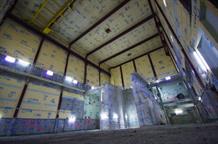What does clean-up and dismantling represent today?
The majority of the world’s nuclear facilities were built from the 1950s to the 1980s. The oldest have been gradually shut down, making way for new activities. There are several reasons for this: completed research or production programmes, obsolete equipment, heavy maintenance or changes to regulations. What happens next? In short, these facilities will be cleaned up and re-used as required, or possibly destroyed. This is referred to as clean-up and dismantling in the nuclear industry. This activity represents a market estimated to be worth 220 billion euros globally over the next twenty years, according to the Arthur D. Little strategy, innovation and technology consultancy. In France, close to forty nuclear facilities are currently concerned.
The CEA: twenty years’ expertise in clean-up/dismantling
Once work has started, clean-up and dismantling takes several years. It is a real “long haul” in which the CEA has a great deal of experience. It has been involved in nuclear research in France for many years and has been managing end-of-life facilities in its own centres for more than twenty, including ‘first generation’ reactors, research reactors, laboratories and waste treatment facilities. “For example, all the facilities at the Grenoble centre have been dismantled. The three reactors - Siloé, Siloette and Mélusine - have already been decommissioned. The decommissioning of the active materials analysis laboratory (LAMA) and two radioactive effluent and waste treatment plants is currently being examined by the French Nuclear Safety Authority (ASN)”, said Bernard Vignau, head of Department at the CEA Nuclear Energy Division (DEN). “This large-scale work, carried out for the first time at site level, has cleared the way for technology research laboratories.”

Inside the cleaned and dismantled former Mélusine reactor building at CEA Grenoble © E. Stanislas/CEA
Twenty-two of the 43 facilities operated by the CEA are currently being dismantled. These include the regulated nuclear installations (INB) at the Fontenay-aux-Roses centre which is being converted from nuclear engineering to biological engineering, the Phénix reactor at Marcoule, the Rapsodie reactor at Cadarache, the UP1 fuel reprocessing plant and the Marcoule pilot workshop. “Each site is different, which means we don’t benefit from a “series effect”. Although we have feedback from one operation to another, we always have to be inventive to find solutions for situations that have never previously been encountered. Every time we learn new aspects from the work and research carried out” said Bernard Vignau. The large diversity of these facilities, due to their type, size or specific technical features, gives the CEA unique project ownership and R&D expertise in clean-up and dismantling or in the retrieval and conditioning of legacy radioactive waste. This know-how is also very valuable for designing future nuclear facilities; every operator is now required to take dismantling into consideration, as is the case with Project ITER – for “International Thermonuclear fusion Experimental Reactor” – which is currently under construction at Cadarache.
Clean-up/dismantling of a regulated nuclear installation: a long haul in a number of stages
But how are such operations carried out in practice? It all starts with the definition of the worksite scenario and the methods and equipment to be used. This involves collecting the input data on the facility (drawings, equipment, etc.) and assessing its radiological state (irradiation rate, contaminated areas, etc.). This scenario is drawn up in line with the facility’s baseline safety requirements. For a regulated nuclear installation (INB) that has reached final shutdown, its status changes from “operation” to “dismantling”. These baseline requirements therefore specify the target final state, analyse the new risks resulting from the operations, and study the resulting waste, releases, and dosimetry, etc.
A new radiological risk map is then drawn up which focuses on the individual workers to ensure they are protected against any contamination or irradiation during the operations. At the same time, an administrative document on waste management is drawn up, assessing its environmental impact to ensure that it will be accepted by the French national radioactive waste management agency (Andra). Based on the chosen scenario and once the relevant French Nuclear Safety Authority (ASN or ASND for activities related to Defence) has given the green light, the preparation phase starts. This involves marking out the boundaries of the operations, installing a ventilation system to protect the work environment and installing the radiation protection equipment.
Work then starts, firstly to remove the materials, then to clean-up, which means cleaning and removing the radioactive substances from the equipment and parts of the facilities. This work is carried out upstream of the dismantling process which involves disassembling and removing all the equipment prior to final site remediation and clean-up of premises. This work can take more than ten years. The end-of-work report, detailing the radiological, safety and waste conditions, will then be used for authorising the total or partial final decommissioning of the facility.
Clean-up/dismantling: a technical challenge and a financial issue
With regard to the cost of this work, Laurence Piketty, Director of Nuclear Clean-Up and Dismantling at the DEN, estimates that “over the next few years, the CEA will spend around 700 million euros per year on its clean-up/dismantling, operation and waste management programmes. Financed by special funds, our provisions currently stand at 16.7 billion euros, 80 to 90 % of which will be ploughed back into French industry.” It is a real challenge for the CEA teams to complete these complex projects while keeping to costs and timescales, and above all at every stage complying strictly with the ‘facilities’ baseline safety requirements set by the ASN. One of the keys for successful compliance with this large number of requirements is targeted R&D, in order to optimise the tools and processes.